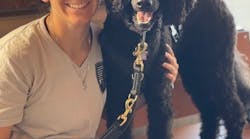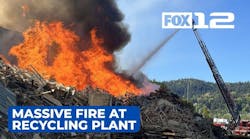W/UI fires have become a serious threat to Texas residents and firefighters alike, and the need to cross-train and cross-equip structural and wildland firefighters to meet this tremendous fire challenge has never been more urgent. The question of how to train and equip these firefighters to safely and effectively fight these fires was on the minds of many fire managers.
Some people in the Texas Forest Service, along with local structural career and volunteer firefighters, recognized the problem and developed two wildland and W/UI fire training academies. One is held each spring in Lufkin and the other has become an annual event in Bastrop, not far from Austin, and is called the Capital Area Regional Wildfire Academy and W/UI Conference. It is the focus of this column.
About The Texas Forest Service
The Texas Forest Service (TFS) has been helping to prevent the loss of lives, property and the environment since 1925. The TFS is a state agency and a member of the Texas A&M University system. The agency provides statewide fire suppression and fire prevention/mitigation programs and assists when other natural or human-caused disasters occur. It is a progressive agency and is one of the nation's leaders in the fight against wildland and W/UI fires.
The TFS has about 350 personnel, of which some 150 work in fire suppression and prevention assignments. TFS personnel work closely with the rural and volunteer fire departments. Wildland fires burn an average of 1 million acres each year in Texas. The Rural Fire Defense Section of the TFS administers a new program, "Industrial Helping Hands," that will directly aid volunteer departments by providing firefighting equipment donated by local industry. As of November 1999, more than $6 million worth of fire equipment had been donated. A new W/UI fire prevention program developed by the TFS was recently unveiled. The program, "Living on the Edge," utilizes a high-tech, multi-media traveling display.
Capital Area Wildfire Academy
Kari Gray, a TFS W/UI specialist in Bastrop, is coordinator of the Capital Area Regional Wildfire Academy and successfully orchestrated the first academy in October 1998. Her staff of TFS employees, including Regional Fire Coordinator and Instructor Rich Gray, and a number of the area's volunteer fire department members ably assisted her. The second annual academy was held Oct. 19-31, 1999 and a Wildland/Urban Interface Conference was added and convened Oct. 29-31.
The academy was conducted on the grounds of the Texas Army National Guard's Camp Swift, an ideal setting. The grounds are heavily wooded, away from the public and include a mess hall/kitchen, barracks for sleeping and individual structures for classroom instruction.
Kari was, once again, the academy coordinator and incident commander (IC). Rich was the operations section chief and is also one of the best instructors at what he teaches. Both worked long hours to make this a highly successful, enjoyable and unique experience. The academy was operated under the incident command system table of organization. Safety was stressed at every morning briefing and no injuries were reported during the entire academy.
One "bump in the road" occurred because some of the academy staff had been assigned to engine strike teams due to the extreme fire danger in locations far from Bastrop and were not available to assist. This created some logistical headaches for Kari, Rich, and Logistics Section Chief Harold Reynolds and the remaining staff. The academy's staff was still most helpful and added to the friendly learning atmosphere that is the Texas style of hospitality.
Classes, Classes And More Classes
More than 20 National Wildfire Coordinating Group (NWCG) certified courses of instruction and several local courses were offered to attendees. Certified instructors from different areas of the country provided an interesting and diverse training experience.
More than 300 firefighters attended the academy. Of that number, more than 60% were structural career and volunteer firefighters of all ranks. Among the courses offered were Basic Firefighter Training, Advanced Firefighter, Fire Operations in the W/UI, Crew/Engine Boss,Dozer/Tractor Plow Boss, Firing Methods/Ignition Specialist, Intermediate Fire Behavior, Task Force/Strike Team Leader, Pumps and Water Use, Wildfire Power Saws, Wildfire Cause and Origin Determination, Interagency Helicopter Ops Training, Class A Foam Use and Defensible Space Training.
Certificates of completion were awarded each student that successfully completed his or her class and task books were signed off where appropriate. Trainee positions were also offered during the academy. The Pack Test was also offered for those wishing to have their Red Cards signed off.
On-The-Job Training
One aspect of the academy that contributed to its uniqueness was what I called "On The Job Training." Due to the extreme wildland fire hazard conditions that prevailed during this academy, engine strike teams were located in certain geographical areas of Texas. One such interagency engine strike team was staged at the academy and was dispatched to a number of fire incidents. Some of the students who were assigned to the strike team had to leave classes to fight fire. Other students, who were firefighters from local structural fire departments, also responded to fire incidents within their own communities.
Firefighter Molly Rochen of the Blue Bonnet Volunteer Fire Department was a student in the S-130/190 Basic Wildland Firefighter class and she had these comments: "I've been able to apply, extremely well, what I have learned at this academy within my role as a structural firefighter fighting wildland fires. Before this academy, I'd just go to the fire and 'put the wet stuff on the red stuff.' But now, after going through the training, I'll be identifying and thinking about the time of day, weather, wind, relative humidity, looking for the different parts of a wildfire, watching for spot fires and thinking about safety issues. All of the different aspects of wildland firefighting have come together for me. Just yesterday, we responded to a wildfire. We were fresh out of the class and it made all the difference than before when we were not trained. This academy has been great."
There were many aspects of the academy that made this an outstanding event. One situation that was particularly rewarding occurred as a result of the thoughtfulness of the students enrolled in the S-212 Wildfire Power Saw class. The students cut down a number of large trees during training. These trees were not wasted. Arrangements were made to have a logging company remove the downed trees and transport them to a sawmill, paying $1,000 for the wood. This money was then donated to a local children's charity by the firefighter students of the power saw class.
Wildland/Urban Interface Conference
The Wildland/Urban Interface Conference was dedicated to Lynn Weiss of the Fire Citizens Advisory Panel because of her tireless efforts to reduce the W/UI fire hazard ratings in the subdivision where she resides from the "Extreme" to the "Moderate" level.
Topics covered during this event were: Defensible Space...Texas Style, by Kari Gray; Organizing Community Involvement, by Lynn Weiss; Rural Water Supply Development, by Mike Fisher of the Bastrop Fire Department; Current Mitigation Activities in Texas, by Jim Blott of the TFS; Fire Ecology and the Phenomenon of W/UI, by Rich Gray; and Structure Protection and W/UI in the Eastern U.S., by the author.
A high point of the conference was a presentation given by Margarita Phillips, a Smokejumper for the U.S. Forest Service based in Missoula, MT. She began her career in 1979 as a firefighter on a Type 2 handcrew on the Salish-Kootenai Indian Reservation just north of Missoula. She went on to a wildland engine crew, then a helitack crew and in 1984 became a member of the famous Lolo Hotshots. She became the first female Smokejumper during the spring of 1988 and has made 200 jumps since then. She has been appointed as the team leader for the U.S.Forest Service Smokejumper Recruitment Program and is still fighting fire by jumping out of perfectly good aircraft.
Demobilization
Rich and Kari Gray said in a statement, "We have had an exceptional academy this year. We've seen a tremendous cooperative interagency effort between local career and volunteer structural fire department personnel, the Texas Forest Service, the county fire departments, the Federal Correctional Facility's Fire Brigade, the Bastrop County Sheriff's Office and the federal wildfire agencies. The folks have not only trained together, side by side; they've fought some fires together. They're forging new friendships, socializing and eating together. The camaraderie has been outstanding and the learning has been very beneficial to the entire fire community."
They continued, "The W/UI fire problem is a major fire consideration for Texas. This academy and conference have helped to heighten the awareness levels of the structural and the wildland fire services about W/UI as never before. There had been a few glitches here and there, but we overcame them and this academy has been a success. We are looking forward to planning next year's academy."
For next year's academy additional classes are being planned and "sub-academies" will be added on such topics as W/UI Fire Suppression; Mitigation and Prevention; and Prescribed Fire. Another W/UI Conference is being considered as a separate and distinct program to be held in a more appropriate setting. The third annual Capital Area Regional Wildfire Academy is scheduled to be held during the last two weeks of October 2000 at Camp Swift. Details will be available in the spring. For further information contact Kari Gray, Academy Coordinator, Texas Forest Service, P. O. Box 1991, Bastrop, TX 78602; telephone 512-303-9749/9734; or e-mail [email protected].
Robert M. Winston, a Firehouse® contributing editor, is a district fire chief in the Boston Fire Department with extensive experience and training in wildland and SWI protection. Questions and comments may be sent to him via e-mail at [email protected]















